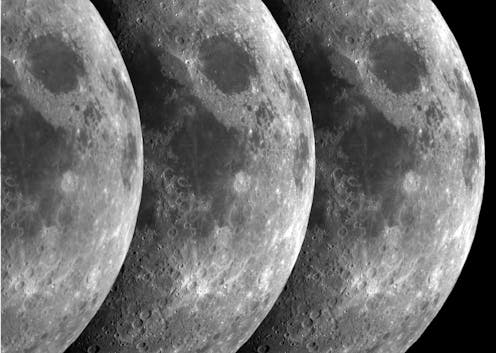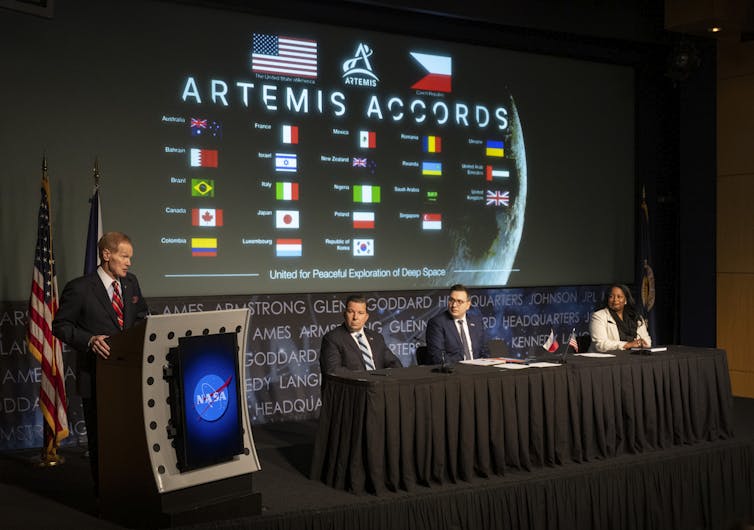Returning to the Moon can benefit commercial, military and political sectors – a space policy expert
While a return to the Moon will allow the U.S. to collaborate with other nations interested in space, this endeavor is also complicated by geopolitical tensions.

NASA’s Artemis program aims to return humans to the Moon for the first time in more than 50 years, with the first human landing currently scheduled for 2025. This goal is not just technically ambitious, but it’s also politically challenging. The Artemis program marks the first time since the Apollo program that an effort to send humans to the Moon has been supported by two successive U.S. presidents.
As a scholar of international affairs who studies space, I’m interested in understanding what allowed the Artemis program to survive this political transition where others failed. My research suggests that this program is not just about advancing science and technology or inspiring the public. It also offers practical benefits for the commercial sector and the military and an opportunity to reinforce U.S. global leadership.
Commercial interest in the Moon
Several companies around the world, including both startups and established aerospace firms, have begun working on missions to the Moon. Some, like Japan-based iSpace and U.S.-based Astrobotic, are developing commercial lunar landers and have plans to eventually collect lunar resources, such as water or minerals.
For now, efforts to return to the Moon are largely funded by government space agencies, like NASA or the European Space Agency. However, many experts talk about the growth of a “cislunar economy,” where companies make money through their activities in and around the Moon.
Expert studies suggest that it will be decades before many activities – like mining lunar resources or collecting solar energy on the Moon – will generate profits. But in the meantime, government space programs can leverage commercial innovation to cut costs, spur innovation and accelerate their programs. And some commercial activity, such as lunar tourism, may be profitable in the near future. SpaceX has already sold one trip to the Moon, tentatively scheduled for launch in 2024.
Companies entering the market early may have an advantage. Crowding is unlikely to be an issue in the near term – the Moon has a surface area roughly equivalent to the entire Asian continent. Even at the poles, multiple sites offer access to both water ice and solar illumination.
However, the first companies on the Moon may set precedents for the extent of lunar mining allowed, as well as the safety and sustainability protocols that others coming later may follow. The United Nations has established a working group to examine the legal issues related to using space resources, but it won’t finish its first set of proposed principles until 2027. In the meantime, commercial entities are already attempting to land on the Moon.
Military interest in the Moon
In 2020, the head of the U.S. Space Force referred to the Moon as “key terrain,” and the Air Force Research Laboratory is funding an experimental satellite called Oracle, scheduled for launch in 2026. Oracle will monitor the space between the Earth and the Moon.
The U.S. military has decades of experience in monitoring spacecraft orbiting the Earth. It could use this expertise to support safety and security as commercial and civil governmental activity near the Moon increases. They could also provide the United States with better intelligence on the space activities of strategic competitors, like China.
Some individuals in the space sector go further and suggest that the military should watch for weapons hidden in deep space or on the far side of the moon. However, the physics and economics of space suggest that these uses are costly, with little practical benefit.
While leveraging U.S. military expertise in space makes sense, there are reasons not to take developments in this area too far. Military advances like these – even if done in support of civil and commercial goals – may raise suspicion from other nations, potentially leading to increased military space activity on their part, and ultimately increasing tensions.
Geopolitical concerns
The Apollo program is famous for its role in the U.S. and the Soviet Union’s mid-20th century “space race.” The United States’ ability to land humans on the Moon was interpreted by many around the world as evidence of U.S. technological superiority and the capabilities of a democratic and capitalist society. Some have suggested that the United States is now in a new space race, this time with China. China recently accelerated its plans to send humans to the Moon.
While not everyone agrees that such a race is taking place, the use of this terminology by U.S. political leaders, including current NASA Administrator Bill Nelson, and its ubiquity in global media coverage suggest that many will view efforts to land humans on the Moon in this way. If China lands humans on the Moon before the United States, people around the world may see this as evidence of China’s role as a global leader and the capabilities of its communist government.
The return to the Moon is not just about competition. It also offers nations opportunities to engage in international cooperation. More than 20 nations have announced plans to undertake missions to the Moon. Just as the United States is leveraging commercial developments, the U.S. is working with international partners, as well. Europe, Japan and Canada have already joined the United States as partners on the Lunar Gateway, a space station that will orbit the Moon, with the first modules expected to launch in 2025.
The United States is also seeking international support for the Artemis Accords, a set of principles for responsible lunar exploration and development. As of July 2023, 27 nations had signed the accords. This includes not just close allies like the United Kingdom, Canada and Japan, but also less traditional partners, such as Rwanda, Nigeria and the United Arab Emirates. India’s signing of the accords in June 2023 was seen as a sign of strengthening ties between the U.S. and India.

It’s worth noting that China’s lunar program also emphasizes international engagement. In 2021, China announced plans to develop the International Lunar Research Station in partnership with Russia, and it has invited other nations to join, as well. Sweden, France, Italy, Pakistan and the United Arab Emirates are all participating in China’s upcoming lunar lander mission.
Ever since humans last left the Moon in 1972, many have dreamed about the days when people would return. But for decades, these efforts have hit political roadblocks. This time, the United States’ plans to return to the Moon are likely to succeed – it has the cross-sector support and the strategic importance to ensure continuity, even during politically challenging times.
Mariel Borowitz receives funding from the the National Aeronautics and Space Administration, the U.S. Department of Defense, and the U.S. National Science Foundation.
Read These Next
How the ‘slayer rule’ might play a role in determining who will inherit wealth from Rob Reiner and h
These rules have a long history in the United States. They played a role in the notorious murders by…
From truce in the trenches to cocktails at the consulate: How Christmas diplomacy seeks to exploit s
World leaders like to talk up peace at Christmastime. But alongside the tales of seasonal breaks in…
As DOJ begins to release Epstein files, his many victims deserve more attention than the powerful me
Powerful men connected to Jeffrey Epstein are named, dissected and speculated about. The survivors,…






